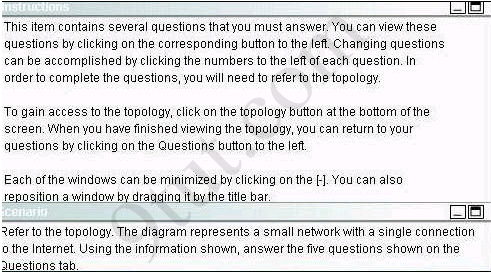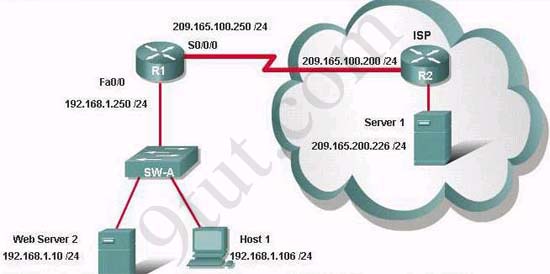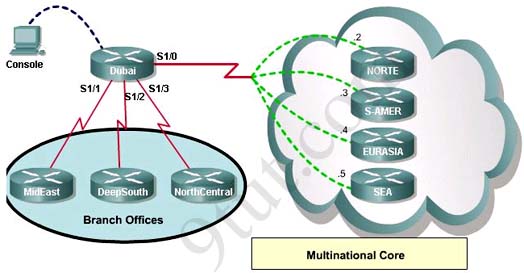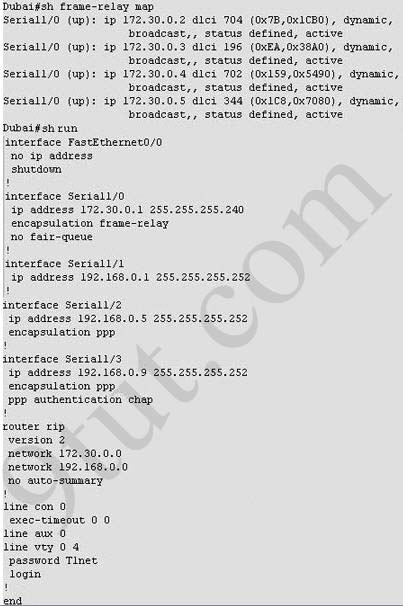CCNA – Hotspot
Here you will find answers to CCNA hotspot Questions
Hotspot Routing Question


Question 1:
If the router R1 has a packet with a destination address 192.168.1.255, what describes the operation of the network?
A – R1 will forward the packet out all interfaces
B – R1 will drop this packet because it is not a valid IP address
C – As R1 forwards the frame containing this packet, Sw-A will add 192.168.1.255 to its MAC table
D – R1 will encapsulate the packet in a frame with a destination MAC address of FF-FF-FF-FF-FF-FF
E – As R1 forwards the frame containing this packet, Sw-A will forward it ti the device assigned the IP address of 192.168.1.255
Answer: B
Question 2:
Users on the 192.168.1.0/24 network must access files located on the Server 1. What route could be configured on router R1 for file requests to reach the server?
A – ip route 0.0.0.0 0.0.0.0 s0/0/0
B – ip route 0.0.0.0 0.0.0.0 209.165.200.226
C – ip route 209.165.200.0 255.255.255.0 192.168.1.250
D – ip route 192.168.1.0 255.255.255.0 209.165.100.250
Answer: A
Quetion 3:
When a packet is sent from Host 1 to Server 1, in how many different frames will the packet be encapsulated as it is sent across the internetwork?
A – 0
B – 1
C – 2
D – 3
E – 4
Answer: C or D(depending on your understand, please read the comments to understand why)
Question 4:
What must be configured on the network in order for users on the Internet to view web pages located on Web Server 2?
A – On router R2,configure a default static route to the 192.168.1.0 network
B – On router r2, configure DNS to resolve the URL assigned to Web Server 2 to the 192.168.1.10 address
C – On router R1, configure NAT to translate an address on the 209.165.100.0/24 network to 192.168.1.10
D – On router R1, configure DHCP to assign a registered IP address on the 209.165.100.0/24 network to Web Server 2
Answer: C
Question 5:
The router address 192.168.1.250 is the default gateway for both the Web Server 2 and Host 1. What is the correct subnet mask for this network?
A – 255.255.255.0
B – 255.255.255.192
C – 255.255.255.250
D – 255.255.255.252
Answer: A
Hotspot Frame-relay Question


(In the old days, this question was a multi-choice question but Cisco upgraded it into a lab-sim question. Therefore, instead of listing all the configuration as above, you have to type show frame-relay map and show running-config to get its configuration)
Note: If you are not sure about Frame-Relay, please read my Frame Relay tutorial.
Question 1:
What destination Layer 2 address will be used in the frame header containing a packet for host 172.30.0.4?
A – 704
B – 196
C – 702
D – 344
Answer: C
Question 2:
A static map to the S-AMER location is required. Which command should be used to create this map?
A – frame-relay map ip 172.30.0.3 704 broadcast
B – frame-relay map ip 172.30.0.3 196 broadcast
C – frame-relay map ip 172.30.0.3 702 broadcast
D – frame-relay map ip 172.30.0.3 344 broadcast
Answer: B
Question 3:
Which connection uses the default encapsulation for serial interfaces on Cisco routers?
A – The serial connection to the MidEast branch office
B – The serial connection to the DeepSouth branch office
C – The serial connection to the NorthCentral branch office
D – The serial connection to the Multinational Core
Answer: A
Question 4:
If required, what password should be configured on the router in the MidEast branch office to allow a connection to be established with the Dubai router?
A – No password is required
B – Enable
C – Scr
D – Telnet
E – Console
Answer: A or D (because maybe there are 2 versions of this question, depending on the output of “show running-config” command, please read the explanation below)
Explanation
This question is not clear for a long time but now maybe the trick was solved. What Cisco wants to ask is the word used as password, not the type of connection, so in the exam you might see some strange words for answers like “En8ble”, “T1net”, “C0nsole”. All you have to do is to use the command “show running-config” as wx4 mentioned below to find the answer.
wx4 commented:
Q4: if password required which?
in my example it was connection to North!
How to figure out which pw is required?
#show running-config
1. check the interface to the router you need connection to. If there is “ppp authentication” you need a password!
2. you will find the password on the top of your running-config output
check the area:
username North password c0nsole
username xxxxx yyyyy
username…
in my case it was c0nsole, in your case it can be no password needed or a different password.
If you are still not clear, please read anton‘s comment:
A big question I noticed here was about the FR Lab regarding the password. You have to perform a show running-config and look for USERNAME and PASSWORD.
i.e.
username South_Router password c0nsol3
username North_Router password t31net
Obviously this has to be en PPP encapsulation, if asked for a posible password for SOUTH_ROUTER you pick c0nsol3, and for NORTH_ROUTER you pick t31net. If you’re running HDLC, i would pick “no password is required”.



Thanks a lot for providing info on this sim. I passed today with 841 thanks to this page.
could someone please, kindly send me latest ccna dumps as i will be writing the exams next week friday unslush2008@yahoo.com
@shannon ur Q1- the router do not forward broadcast, so that is why it drops it but if it were a switch it thus forward broadcast.
All can be
The Frame-Relay SIM was on the 640-816 exam today. Just to let others aware who are taking the exam soon, there is a typo on one of the questions.
What destination Layer 2 address will be used in the frame header containing a packet for host 172.30.4.4? <—- 172.30.4.4 should be 172.30.0.4; answer still remains the same by using the "show frame-relay map" command on the main router.
can you telnet :
NORTE
S-AMER
EURASIA
SEA
????????
because as i see some of the questions needs a look in the config of these routers since this is a multi-point topology…..
I really respect what you’re posting here. Keep posting that way. Take care!
I shall be thankful to that person who shall provide me latest dump of 640-802 email on kashiflf@hotmail.com, thanks in advance
@shannon
Routers dont forward broadcast so the answer is wrong
I need Help from all of you guys, Please could you tell me which one the correct answer for Question number 4 http://www.9tut.com/ccna-hotspot-questions {hotspot frame-relay QUESTION}.
I ask anyone took the test, what their answer ? , and why ? If no password is required
Please help me and thank for all of you.
hello all,could some one help Qn.5.why the correct answer is A not D?
also i need latest ccna dumps deaparately one one who can help out there?:mkisochi@yahoo.com
Kind regards
Hi,
Can someone kindly send me the latest dump for 640-802. Email address is kammy85@hotmail.com – please put 640-802 in subject line so i dont think its spam lol
Many thanks in advance
K
Topology:
Host A -> Router 1 s0/0 -> S0/1 Router 2 s0/0 -> S0/0 Router 1
Host A pings interface s0/0 on router 3. What is the TTL value for the ping?
A. 253
B. 252
C. 255
D. 254
Answer: A
Any idea why the answer is A?
Topology:
Host A -> Router 1 s0/0 -> S0/1 Router 2 s0/0 -> S0/0 Router 3
Host A pings interface s0/0 on router 3. What is the TTL value for the ping?
A. 253
B. 252
C. 255
D. 254
Answer: A
Any idea why the answer is A?
Thank you! 9 Tut! ;D
@JM host A across two router
So A is correct
A few thoughts :
1)for question 3 of hotspot routing question…the answer should be 3 ..that is the packet gets encapsulated 3 times…
2) also i came across a frame relay question in which it asks “what password should be configured on Deepsouth router to allow a connection with MidEast router???? how to do tht???…we cant access Deepsouth or the Mideast router …so is there any info on Dubai router tht will help answer such a question????????
3) Also i want to know for hotspot routing, Q1, why isnt D correct..a router fwds broadcasts….otherwise whats the use of Broadcast address ??..isnt it used for sending out packets to all hosts in a given network???…then y is the answer B: ie not a valid ip address?????
Hoping to get some feedback !!..on all my thoughts …possibly…:)
Host A -> Router 1 s0/0 -> S0/1 Router 2 s0/0 -> S0/0 Router 3
Host A pings interface s0/0 on router 3. What is the TTL value for the ping?
A. 253
B. 252
C. 255
D. 254
Answer: A
Any idea why the answer is A?
please define it brief…….
@arunesh:
TTL value= 255- no. of hops(routers passed)
here the packet passes over 2 routers..as per the path u have mentioned…(ie router 1 and router 2)..remember, the packet didnt cross or pass router 3..its destination was the interface S0/0 of router 3. so it passes router 1 and router 2 …ie 2 routers…so
TTL value= 255-2= 253 is the TTl value…hope this helps..!!
@Deepti
Not sure about your 2nd thought, but for your 3rd thought – routers define broadcast domains but do not forward broadcasts, switches will forward broadcasts, that is why you can have multiple switches in a broadcast domain.
@ deepti
HDLC is configured on the s1/1 interface which one corresponds to the MidEast and it is the default encapsulation for serial interfaces and it doesn’t requiere any authentication because of that I think that there in no need for a password.
I am thinking to take the exam on August 26th, but I am a little worried about Security Teslet.
@9tut
please review question 3. i believe the answer should be D.
link: https://learningnetwork.cisco.com/message/69156#69156
@9tut
Hotspot Frame-relay Q4
you already gave an output of *show running-config*, the password for telnet is *Tlnet*
please fix option D
D – Tlnet
and set D as the answer for this question
Could you please provide latest hot spot questions?
for question 3 :When a packet is sent from Host1 to Server1,in how many different frames will the packet be encapsulated as it is sent across the internetwork?…
what’s the answer…if any1 is damn sure pls let me know…i have an exam tomorrow..
@deepti
host –> default gateway (1)
R1 –> R2 (2)
R2 –> server (3)
i’m counting 3 frames.
yeah to me it seems 3 too..but a lot of ppl claim its 2…i dont know depending on what is the answer 2?..something to do with encapsulation?…whatever it is ..i feel tht basically the packet undergoes framing 3 times as its sent frm host 1 to server 1…any thots ??
Hotspot Routing Question
Q4:
I understand that answer should be router R2,configure a default static route to the 192.168.1.0 network, because if internet users want to see private users, NAT 1-1 should be configured.
Is C answer incorrect ?
@ Deepti and Xallax. I am not pretty sure but I think that are two frames. This is my suggestion when the frame arrives to the serial link it doesn’t matter the MAC address, because it is a point to point connection because of that I don’t count this step as a frame encapsulation. The frames are in the Ethernet interfaces where the router creates a new data-link frame with its interface’s MAC address as the source and the destination MAC is the Server’s MAC address. If I am wrong plz let me know.
I am gonna take the exam this friday. I am very nervous.
THX
@nerroazurro
data goes through encapsulation and decapsulation as it passes along the network.
you agree that all these devices (pc, R1, R2, server) operate at both layer1 and layer2. there is no doubt about it.
* PC has that to send, builds a segment with source/destination ports and sets the transport layer protocol of choice (TCP or UDP), builds a packet with source/destination IPs, gets the packet into a frame with source/destination MAC addresses, transforms the frame in bits, sends data to R1
* R1 gets the bits, converts them to a frame, reads the destination MAC of the frame, decapsulates the frame, reads the source and destination of the packet, checks the routing table, sends the packet to the appropriate exit interface, encapsulates the packet in a frame with new source/destination MACs, converts the frame to bits, sends the bits to R2
* R2 receives the bits, checks the MAC, decapsulates the packet, checks the destination IP, sends the packet to the right exit interface, builds the frame with new source/destination, converts the frame to bits, sends it to the server.
* the server gets the bits, builds frame, checks destination MAC, decapsulates the frame, checks the IPs, decapsulates the segment, checks the source/destination ports, decapsulates the data.
how many frames?
1: PC – R1
2: R1 – R2
3: R2 – server
wrote it without checking it…
there are no MACs on serial links, my bad. everything else stays
Q4: Hotspot Routing Question
I understand that answer should be; “router R2,configure a default static route to the 192.168.1.0 network”, because if internet users want to see private users, NAT 1-1 should be configured on R2
Is C answer incorrect ?
Q.3 Answer is 3
Explanation:
First: Host1 encapsulates the packet into frames and forwards to the switch.
Switch in turn forwards the same frame to router R1.
Second: Router R1 receives the frame on one interface and it is encapsulates into new packet once it leaves the router R1 towards the direction of server1.
Third: R2 receives this packet and it also encapsulates the frame into new packet when it is forwarded to server1 on different interface of R2.
Therefore the packet is sent using three different frames to reach from Host1 to server1.
When a packet is sent from Host 1 to Server 1, in how many different frames will the packet be encapsulated as it is sent across the internetwork?
A – 0
B – 1
C – 2
D – 3
E – 4
Answer: D – 3
https://learningnetwork.cisco.com/message/69455
got a small doubt with question3…??
host 1 sends frame to switch;
switch encapsulates the frame into segments (host/dest mac addresses) & 4wards 2 Router1;
router1 encapsulates the frame into packets (host/dest ip addresses);
now what will router2 do..??
i am just a beginner, no intentions to confuse or spread wrong info, apologies.. kindly help..!!
rohit;)
@rohit4rmgoa
the switch does not encapsulate anything, it just reads and forwards.
layer keyword:
L1: bits
L2: frame
L3: packet
L4: segment
you have used the keyword “segment” when referring to a L2 operation made by the switch. that is incorrect.
host1 sends to router1
router1 sends to router2
router2 sends to server1
thank you for asking, hope this helps
Hi, Appreciate if someone could send me the latest dumps at treepanel.ken@hotmail.com , i plan to take the exams at the end of sep.
Thanks.
Guys, this is really helpful as i’m preparing to take the exams also by sept. ending,latest dumps is highly appreciated,ibukun_nelson78@yahoo.in
hi,
so is the answer to question three, 2 or 3 ?
thanks
just took the cisco 640-802 exam friday, did not pass with score 762. found this site looks like very good and similar questions and sims to the exam. i am believing from reviewing this site if i study the questions/answers and do the sims i can pass. also if anybody has any useful info for preparing i am traitt@yahoo.com
thanks
hello, i also will be taking the CCNA in a couple weeks or so (retake) if anybody can also send last dumps to traitt@yahoo.com thanks.
Router1>show version
System image file is “tftp://172.16.1.129/hampton/nitro/c7200-j-mz”
A. Router 1 has specific boot system command that instruct it to load IOS from TFTP server.
B. Router 1 is acting as a TFTP server for other routers.
C. Router 1 cannot locate a valid IOS image in flash memory.
D. Router 1 defaulted to ROMMOM mode and loaded the IOS image from a TFTP server.
E. Cisco routers will first attemp to load a image from TFTP for management purposes.
What are the best two answers? I think A and E. But i saw someone answered A and C.
Q3 The answer is C because the question asks how many different frame (types) of encapsulation.
1st type as it leaves the host to the switch before it hits the router
2nd as it goes across the serial link
then back to the first type as it then goes into the router and across the lan to the server.
While there are 3 occasions of encapsulation, there are only 2 types.
Great site and a great help
@Justin: By default Cisco router looks valid IOS image in:
Step 1: in flash mem. if it no image in flash go to step 2
Step 2: looks image on TFTP server if no image go to step 3
Step 3: boot in ROMMON mode
So correct answers are: A (specific boot instruction in config) and C (step 2 in default booting sequence).
hello, i also will be taking the CCNA by next week wednesday pls can you send the latest dump too segunfemmy@yahoo.com. thanks
Hi, can any one send me dumps for ccna exam to rmehar_sk@yahoo.com…i am taking next weekend…….any suggations for preperation???????
Q2 why is the answer is A and not B? 9tut or anyone please explain.. thanks
@rose: In answer B, the destination IP address is not correct
“ip route 0.0.0.0 0.0.0.0 209.165.200.226″ -> the destination IP should be 209.165.100.200
@xallax
which network protocol does DNS use?(choose one)
FTP,TFTP,TCP,UDP,SCP
i am really confused because DNS uses both UDP and TCP (port 53).which is correct?.the dumps say UDP
@ayaj
so…
udp is used when the request/reply have small amounts of data.
looking at your questions… it asks which NETWORK protocol is used. that’s stupid. ftp/tftp are applications, tcp/udp are transport layer protocols. what is scp?
“DNS primarily uses User Datagram Protocol (UDP) on port number 53 to serve requests.[5] DNS queries consist of a single UDP request from the client followed by a single UDP reply from the server. The Transmission Control Protocol (TCP) is used when the response data size exceeds 512 bytes, or for tasks such as zone transfers. Some operating systems, such as HP-UX, are known to have resolver implementations that use TCP for all queries, even when UDP would suffice.”
http://en.wikipedia.org/wiki/Domain_Name_System